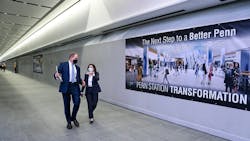New York Governor Hochul announces work to redesign New York Penn Station anticipated to begin in coming months
A contract was approved by the Metropolitan Transportation Authority (MTA), in partnership with New Jersey Transit (NJ Transit) and Amtrak, for the redesign of Penn Station to a joint venture led by FXCollaborative Architects LLP and WSP USA Inc., with the British architect John McAslan + Partners as collaborating architect.
McAslan + Partners designed the 2012 transformation of London's historic King's Cross Station, creating a 165-yard-long semi-circular departures concourse that integrates regional and intercity railroads with each other and with the London Underground while welcoming natural light from the sky through 1,000 glazed and translucent triangular roof panels.
"Since crews took a wrecking ball to the original Penn Station in 1963, generations of New Yorkers have been united in their call to build a new station worthy of New York," said New York Gov. Kathy Hochul. "By approving the contract for the redesign of Penn Station, we move another step closer to getting it done. The transformation of Penn cannot come soon enough and we look forward to building a world-class station that puts New Yorkers first, delivers a rider-focused transit experience and a great neighborhood they deserve."
The FXCollaborative and WSP joint venture developed the Penn Station Master Plan unveiled last year that evaluated alternatives and created the preferred redesign plan for Penn Station as a single-level facility centered around a grand train hall with a 450-foot-long sky-lit atrium between Madison Square Garden and 2 Penn Plaza.
"Awarding the design contract is a huge step forward in Gov. Hochul's effort to make Penn Station –once again—a safe, world-class transit facility. The work will take place on an aggressive timetable. The opening of Grand Central Madison in just a few months provides us with a once-a-century opportunity to rebuild Penn Station. With a sizeable percentage of LIRR riders expected to shift their trips to Grand Central Madison, Penn Station will have five years with lower customer volumes before a new influx of customers arrives on Metro-North Railroad by 2027. The MTA wants to get the most disruptive work done before then, so I'm thrilled we are moving forward quickly with the design phase of this massive, long-delayed effort."
The design called for by the MTA's contract will advance that preferred alternative and will:
- Relieve overcrowding and improve passenger flow and orientation.
- Improve safety by increasing platform and station egress and accessibility.
- Alleviate the cramped, disjointed circulation areas with widened concourses and high ceilings.
- Create a clear street presence that integrates with the surroundings.
- Optimize retail and other revenue generation.
- Integrate Penn Station with Moynihan Train Hall and the planned Penn Station Expansion.
"This step brings Amtrak passengers, New York and New Jersey commuters and local residents closer to a new Penn Station for the 21st century,” Amtrak Board Chair Tony Coscia said. “Building upon the ongoing improvements already underway at Penn, this design effort will help the three railroads develop a common, realistic and achievable plan for reconstructing Penn Station while ensuring continued train operations and complete coordination with the Gateway Program investments. We thank Governors Hochul and Murphy for their leadership and partnership and look forward to further collaboration as we transform New York Penn Station into a world-class, state-of-the-art train station."
The recommendation for the design joint venture follows an open, competitive request-for-proposals process that was widely advertised and sent to 106 prequalified firms and attracted five proposals from firms and joint ventures that were reviewed and scored by representatives from MTA Construction & Development, Amtrak and NJ Transit, and assisted by a Technical Advisory Committee with additional representatives from the Long Island Rail Road, Empire State Development and the New York City Economic Development Corporation.
The base contract of up to $57.9 million would develop the preliminary station design and would last for one year. This contract includes options covering preliminary design for improvements to nearby subway stations and design and engineering support as the station reconstruction moves forward.
In keeping with the MTA's program to encourage the growth and development of certified Disadvantaged Business Enterprises (DBE), the MTA's Department of Diversity and Civil Rights has assigned a 22.5 percent DBE goal to the contract.
